How deep is your salmon fly fishing?
by John Gray
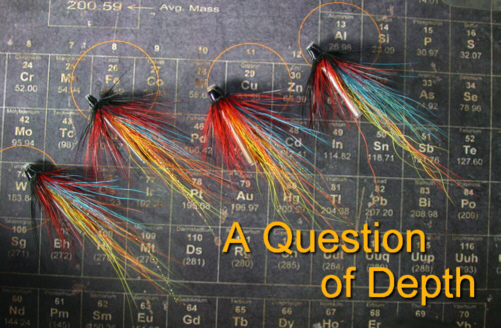
How deep is your fly? While fishing down a salmon pool, do
you have a clear picture of where your fly is and how it is
behaving? For my own part, I have to confess that, for much of
the time, I have only a vague notion of how deeply my fly is
fishing. I might picture my size 8 Cascade double, tied to a
twelve foot leader on a floating line, fishing somewhere between
four inches and a foot below the surface; or my one inch copper
tube on an intermediate line sinking to a depth of two to three
feet. But I have never been at all sure. Fly depth will, of
course, depend on the line density, leader composition and
length, fly size and weight, the strength of the current, the
angle of the cast, the manipulation of rod and line and the
speed of retrieve. So many variables! Yet getting this vital
element right may mean the difference between a fish on the bank
and yet another blank day, and I have enough of them. So my
resolution for 2015 is to gain more control of the situation, or
at least to know more about what is going on at the business end
of my line.
Much has
been written, over the years, on the best depth to fish our
salmon flies. There appears to be fairly widespread agreement
that, in the cold waters of early season and again, though
perhaps to a lesser extent, in late autumn, we should generally
aim to fish our flies deeply, to bounce our flies off the noses
of deep lying fish disinclined to expend a lot of energy chasing
flies fished several feet above their heads; conversely, when
air and water temperatures rise in the summer months, we are
advised to fish our flies on or near the surface. It would not,
I think, be unreasonable to assume that there will be times in
between when we might profitably fish our flies at various
intermediate depths. The best depth, of course, may not be
easily fathomed - and might in fact be considered the sixty-four
dollar question - but the more control we have over the depth we
fish our flies, the better. Indeed, depth and speed might well
be even more important, on occasion, than fly pattern.
In the
early days of salmon fly fishing, the attainment of depth was
severely limited by the lines available at the time. A silk line
would float for a time if greased and, if left ungreased, would
sink slowly but to no great depth. If the angler wanted to fish
deeply, he would need to use a heavily weighted fly, dressed on
a very large hook or on a heavy copper tube of perhaps three
inches in length.
Today's
fly fisherman is governed by few such restrictions. Indeed,
refinements in fly fishing tackle, in particular in the variety
of line densities and profiles now available, combined with a
wide assortment of fly hooks and fly tubes in a variety of
materials, weights and shapes, allow him to fish at pretty much
any depth he chooses, and he can do so with greater ease than
ever, assuming that he can make sense of it all in combining
rod, line and fly to most effectively achieve the job in hand,
no mean task given the seemingly overwhelming choices now forced
upon us by modern technology. Get the combination of line and
fly right, though, and the rewards can be great. Here is where
a bit of time spent in (literally) weighing up the options might
be very worthwhile.
In the
March 2015 issue of Trout & Salmon, modern options on optimum
line and leader combinations for varying fly fishing depth were
usefully explained in some detail in the article "Which Line for
Spring Fishing?" In that same issue, I read with equal interest
"The Weighting Game" by Peter Gathercole, looking at tube and
cone selection in the attainment of depth in early season
fishing, i.e. the second half of the line/fly equation. While
it is important to know which materials and tube/cone
combinations are heaviest and which will fish more deeply than
others, I found myself asking, "But precisely how deep, for
example, will a one inch aluminium tube fly fish compared to a
fly dressed on a double hook, and how much more deeply can we
expect a one inch copper tube fly, or a tungsten tube fly, to
fish?" So I resolved to find out.
Sink rates
of objects, such as tube flies, vary with density (weight per
unit volume) and shape. Anything with a density greater than
that of water (1 g/cm3) will sink. The table above right shows
the approximate densities of some of the materials most commonly
used in modern flies and tubes:
Note:
the addition of a steel hook to nylon and aluminium tubes will
increase the overall average density of the tube fly, while a
hair and feather dressing will decrease the average density of
all items.
A tube
made from a dense material such as tungsten will sink more
rapidly than one of equal dimensions made from a less dense
material such as aluminium because the downward gravitational
force on the tungsten tube will be greater than that on the
aluminium tube but the opposing upward buoyant force will be the
same in both cases, because both displace the same volume and
weight of water. In addition, a denser tube will more readily
overcome the lateral force of the river flow in preventing it
from sinking. Note that I say "denser" rather than "heavier",
for it is not the weight but the density and shape of an object
which will determine how quickly or deeply it will sink. This
might be easily illustrated by comparing the sink rate of a two
gram nylon tube with that of a one gram tungsten tube. Which one
would sink faster?
So, in
line with our table of relative densities, we can expect an
aluminium tube to sink more rapidly and fish more deeply in
flowing water than a nylon tube, a stainless steel tube to fish
more deeply than the aluminium and so on - but
precisely how much more deeply?
And how would varying the weights and lengths of the tubes
affect sink rates and fishing depth?
My first
step was to gather together a selection of commonly used hooks
and tubes in a variety of materials and sizes as shown above
right.
I first
weighed each item. I then added a common, shrimp style dressing
to all items (omitting a body dressing for simplicity and ease
of identification). On reweighing them, I found that the
dressing added 0.1g to the weight of each. It should be noted
here that adding a dressing, despite the increased weight, is
likely to reduce the sink rate of any hook or tube, because it
reduces the overall density, while increasing buoyancy. In
addition, the added bulk of the dressing creates greater water
resistance on the sinking fly. Hence, a fly with a bulky
dressing will tend to sink more slowly than one with a sparse
dressing. Waddington shanks and tubes were fitted with size 10
Fulling Mill tube fly doubles during testing, adding a further
0.2 grams to their weights.
So how did
I then carry out the tests to find out how deeply each fly would
fish?
I selected
a section of the River Spey (The Upper Bend) on the Strathspey
Angling Improvement Association water above Grantown, a nice bit
of fly water with a steady, even flow (measured on the day
running at a level of 1 ft 3 inches above summer level and at a
speed of 0.75 metres/sec). I waded into the stream to a depth of
three feet and anchored a weight attached to a float. This
provided a fixed point from which to carry out the tests. To the
float I tied a 10 foot length of floating fly line, connected in
turn to a ten foot leader of 12 lb Maxima nylon, to which the
test items were tied in turn and the depth at which they each
fished measured using a metre stick.
I first
tested all flies, measuring the fishing depth of each before
adding a 1.3 gram tungsten conehead to the front of each and
retesting. The results are shown in Table 2 below.
Table 2
Showing the depth (cms)
to which various flies and tube flies sink when attached to a
ten foot leader on a ten foot length of floating line in a river
current flowing at 0.75 metres/sec (a moderate flow)
|
Item |
Size/Length |
Weight (including
hook and dressing) |
Fishing Depth cms |
|
Single Hook |
Size 6 |
0.35g |
14
|
|
Double Hook |
Size 6 |
0.5g |
18 |
|
Waddington Shank |
1 inch |
0.5g |
16 |
|
Waddington Shank |
1 1/2 inch |
0.7g |
18 |
|
Nylon Tube |
1/2 inch |
0.37g |
0 (skated) |
|
Nylon Tube |
1 inch |
0.45g |
0 (skated) |
|
Nylon Tube |
1 1/2 inch |
0.52g |
0 (skated) |
|
Aluminium Tube |
1/2 inch |
0.39g |
0 (skated) |
|
Aluminium Tube |
1
inch |
0.48g |
0-2
(occ. skated) |
|
Aluminium Tube |
1 1/2
inch |
0.57g |
5 |
|
Stainless Steel Tube
1.8mm O.D. |
½ inch(15mm) |
0.49g |
16 |
|
Stainless Steel Tube
1.8mm O.D. |
1 inch (25mm)
|
0.62g |
18 |
|
Stainless Steel Tube
1.8mm O.D |
1½ inch (35mm) |
0.75g |
20 |
|
Copper Tube 3mm O.D. |
1/2 inch |
0.8g |
20 |
|
Copper Tube 3mm O.D. |
1 inch |
1.2g |
22 |
|
Copper Tube 3mm O.D. |
1 1/2 inch |
1.6g |
25 |
|
Tungsten Tube |
1/2 inch |
1.5g |
30 |
|
Tungsten Tube |
1 inch |
2.6g |
50 |
Adding a
1.3 gram tungsten conehead to the front of any of the flies
added approximately 25cms to the depth each fished. |
________________________
Table 1
Densities of
Common Materials
|
Material |
Density (g/cm³) |
|
Water |
1.0 |
|
Nylon |
1.1 |
|
Aluminium |
2.7 |
|
Steel (hooks) |
7.8 |
|
Stainless Steel
(304) |
8.0 |
|
Brass |
8.5 |
|
Copper |
8.9 |
|
Tungsten |
19.6 |
Common Salmon Hooks and Tubes
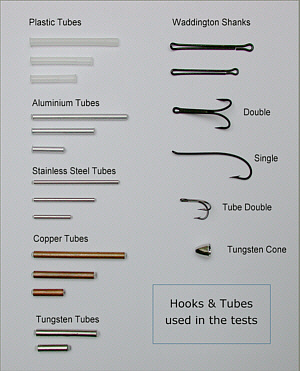
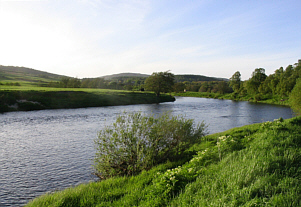
River Spey
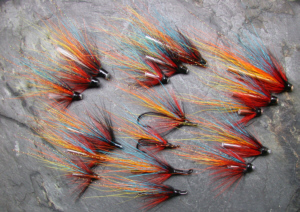
Dressed Flies
which were tested - from top left: plastic tubes, aluminium
tubes, copper tubes, tungsten tubes, hooks and Waddington
shanks, stainless steel tubes
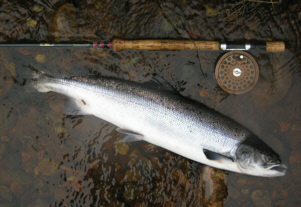
One of two
River Nairn salmon taken within minutes of each other on a
stainless steel Magus tube fly fished on a neutral density
line
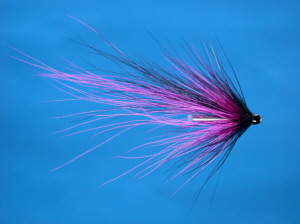
The Magus
Tube Fly
|
|
|
The results
show that the depth to which a fly sinks correlates quite
closely to the density of the material from which the hook or
tube is made (moreso than the weight of the fly). For example,
in a moderate current of 0.75 m/sec, a one inch nylon tube
(density 1.1), although it weighs 0.45g with a double hook
attached, floats; an aluminium tube (density 2.7) struggles to
sink; a size 6 single hook (density 7.8) sinks to a depth of
14cms; a one inch stainless steel tube (density 8.0) sinks to a
depth of 18 cms; a one inch copper tube (density 8.9) sinks to a
depth of 22 cms; and a one inch tungsten tube (density 19.6)
sinks to a depth of 50 cms.
Note that the
copper tube sinks only 4cms more than the stainless steel tube,
although it weighs almost twice as much. The stainless steel
tubes, although only marginally less dense than the copper
tubes, are significantly lighter than the equivalent lengths in
copper because they have a smaller diameter (copper - 3mm,
stainless steel - 1.8mm).
The
simplified illustration below, derived from the above Table 2,
shows the fishing depths of a selection of flies, dressed on one
inch long hooks and tubes of varying density/weight, when fished
on a floating line in a moderate flow.
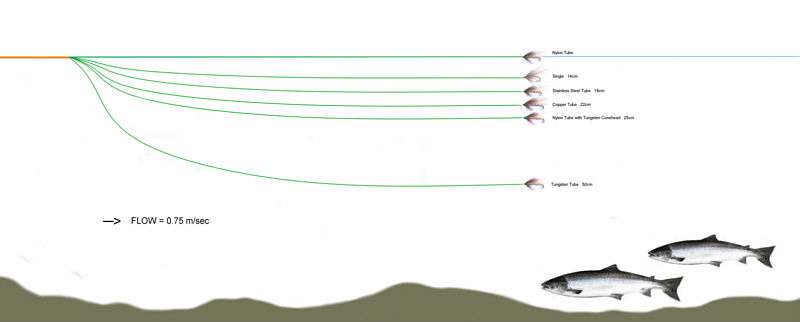
click image to enlarge
From this,
we see that it is possible, using a floating line in a moderate
current, to fish at depths ranging from 0 (nylon tube) to almost
a metre (tungsten tube plus tungsten cone), simply by a change
of fly. Note that these depths are with the fly on the dangle,
fishing directly downstream of the rod. By casting at varying
angles, mending and/or retrieving line etc. we can, of course,
achieve more or less depth if required. Armed with this
information, I feel that I can now predict more accurately how
deeply a particular fly will fish and select a fly more
confidently to achieve the desired depth. If I add the further
permutations made possible by changes in fly line density, the
addition of sinking tips etc. I can fish at virtually any depth
I like.
So this
season, by careful combination of line and fly, and with a new
awareness of relative fly sink rates, I will be in a much better
position to control the depth of my fly and to know more
precisely how it is behaving. Now I just need someone to tell me
what depth is the right one in any given circumstances! |